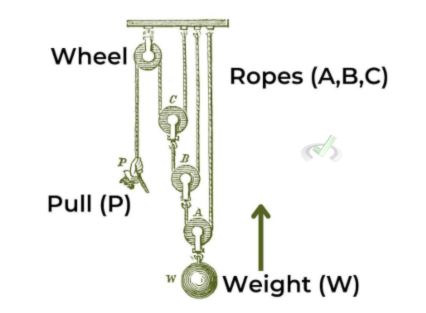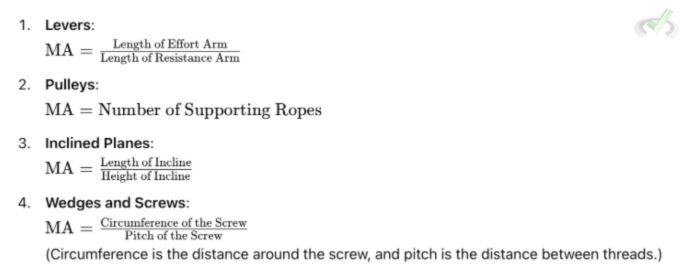Mechanical advantage is a key concept in physics that helps us understand how machines make work easier. It explains how machines can multiply force to do certain tasks that would otherwise be too difficult or impossible to do by hand.
I. Introduction to Mechanical Advantage
Think of yourself using a lever to lift a heavy rock or a pulley to raise a flag. These machines make the task easier because they have mechanical advantages.
Mechanical advantage (MA) is how a machine multiplies the force you put into it. This means you can use less force to accomplish a task. For instance, lifting a heavy load with a lever or pulley requires less effort than lifting it directly.
II. Understanding Mechanical Advantage
We must look at how different machines use it to grasp the idea of mechanical advantage. Let's explore some key types of machines and their mechanical advantages:
Levers
A lever is a simple machine that consists of a rigid bar that pivots around a point called the fulcrum. The lengths of the arms on either side of the fulcrum determine the lever's mechanical advantage.
For example, you gain a mechanical advantage if the effort arm (the part where you apply force) is longer than the resistance arm (the part that lifts the load). This means you can lift heavier loads with less effort. When you push down on the long end of a seesaw, the other end rises, lifting a heavier weight with less force.

Pulleys
A pulley is another simple machine that changes the direction of a force. When multiple pulleys are used together in a system, the force applied can also be multiplied.
For instance, if you use a pulley system with four ropes supporting the load, the mechanical advantage is three. This means you only need one-third of the force to lift the load compared to lifting it directly. A flagpole with multiple pulleys makes it easier to raise the flag because each pulley adds to the mechanical advantage by distributing the force needed.

Inclined Planes
An inclined plane is a flat surface, which is set at an angle to the horizontal. It allows you to move a load up with less effort than lifting it vertically.
The longer the incline compared to its height, the greater the mechanical advantage. This means you can move heavier objects upward with less force. For example, ramps help move heavy items into a truck more easily than lifting them straight up. The shallower the ramp (longer incline), the easier it is to push the load upward.
Wedges and Screws
A wedge is a material that is thick at one end and then tapers to a thin edge. It splits or cuts objects apart. A screw is an inclined plane that is wrapped around a cylinder. It converts rotational force to linear motion.

III. Calculating Mechanical Advantage
To calculate mechanical advantage, you can use specific formulas for each type of machine. Here are some examples:

These formulas help you determine how much easier a machine makes a task.
IV. Practical Applications of Mechanical Advantage
Understanding mechanical advantage has many practical applications. Let's look at a few:
Construction
In construction, cranes and pulleys are used to lift heavy materials. Workers can lift large loads with relatively little effort by using machines with high mechanical advantages. This makes building structures safer and more efficient. For example, a crane uses a system of pulleys to lift heavy beams into place.
Daily Life
Simple tools like scissors and wheelbarrows use mechanical advantage to make tasks easier. Scissors use the principle of levers, and wheelbarrows combine levers and inclined planes. These tools help us perform everyday tasks with less effort. When you use scissors, the long handles (effort arms) make it easier to cut through materials with less force.
Engineering
Engineers design machines and structures considering mechanical advantage to ensure efficiency and safety. For example, designing elevators, escalators, and lifting systems relies on this concept.
Understanding mechanical advantage allows engineers to create devices that move heavy objects with minimal force. Elevators use a system of pulleys and counterweights to lift people and objects smoothly.
V. Mechanical Advantage and its Connection to Other Concepts
Mechanical advantage is closely related to other important physics concepts:
Work and Energy
Mechanical advantage helps us understand how machines reduce the work needed to move an object. Work is the product of force and distance (Work = Force x Distance). By using machines, we can reduce the force required and increase the distance, making tasks easier to accomplish.
Force and Motion
Studying mechanical advantage also involves understanding forces and how they cause objects to move. It connects with Newton's laws of motion, especially the second law, which states that Force = Mass x Acceleration. This law helps explain how applying a force to a mass causes it to accelerate.

Efficiency
Mechanical advantage doesn't account for friction and other real-world inefficiencies. Efficiency measures how much useful work a machine does compared to the energy it uses.
In real life, no machine is perfectly efficient. Some energy is always lost to friction, heat, or other factors. For example, in a pulley system, friction in the ropes and pulleys reduces the actual mechanical advantage.
VI. Wrap-Up and Key Terms
Let's review the key points about mechanical advantage:
- Mechanical Advantage (MA): The factor by which a machine multiplies the force put into it.
- Levers: Simple machines that use a rigid bar pivoting around a fulcrum to multiply force.
- Pulleys: Systems that change the direction of a force and can multiply force when used in combinations.
- Inclined Planes: Flat surfaces set at an angle to reduce the effort needed to move objects upward.
- Wedges and Screws: Simple machines that use inclined planes to split objects or convert rotational force to linear motion.
- Efficiency: The measure of how much a machine does useful work compared to the energy put into it.
VII. Practice Questions
Sample Practice Question 1
What determines the mechanical advantage of a lever?
A. Length of Effort Arm / Length of Resistance Arm
B. Number of Supporting Ropes
C. Length of Incline / Height of Incline
D. Force / Area
Ans. A
The mechanical advantage of a lever depends on the lengths of the arms on either side of the fulcrum.
Sample Practice Question 2
How does a pulley system increase mechanical advantage?
A. By increasing the length of the effort arm
B. By adding more supporting ropes
C. By increasing the height of the incline
D. By decreasing the distance moved
Ans. B
The mechanical advantage of a pulley system increases with the number of ropes supporting the load, making it easier to lift.







 To help you achieve your goal MCAT score, we take turns hosting these
To help you achieve your goal MCAT score, we take turns hosting these 





















 reviews on TrustPilot
reviews on TrustPilot